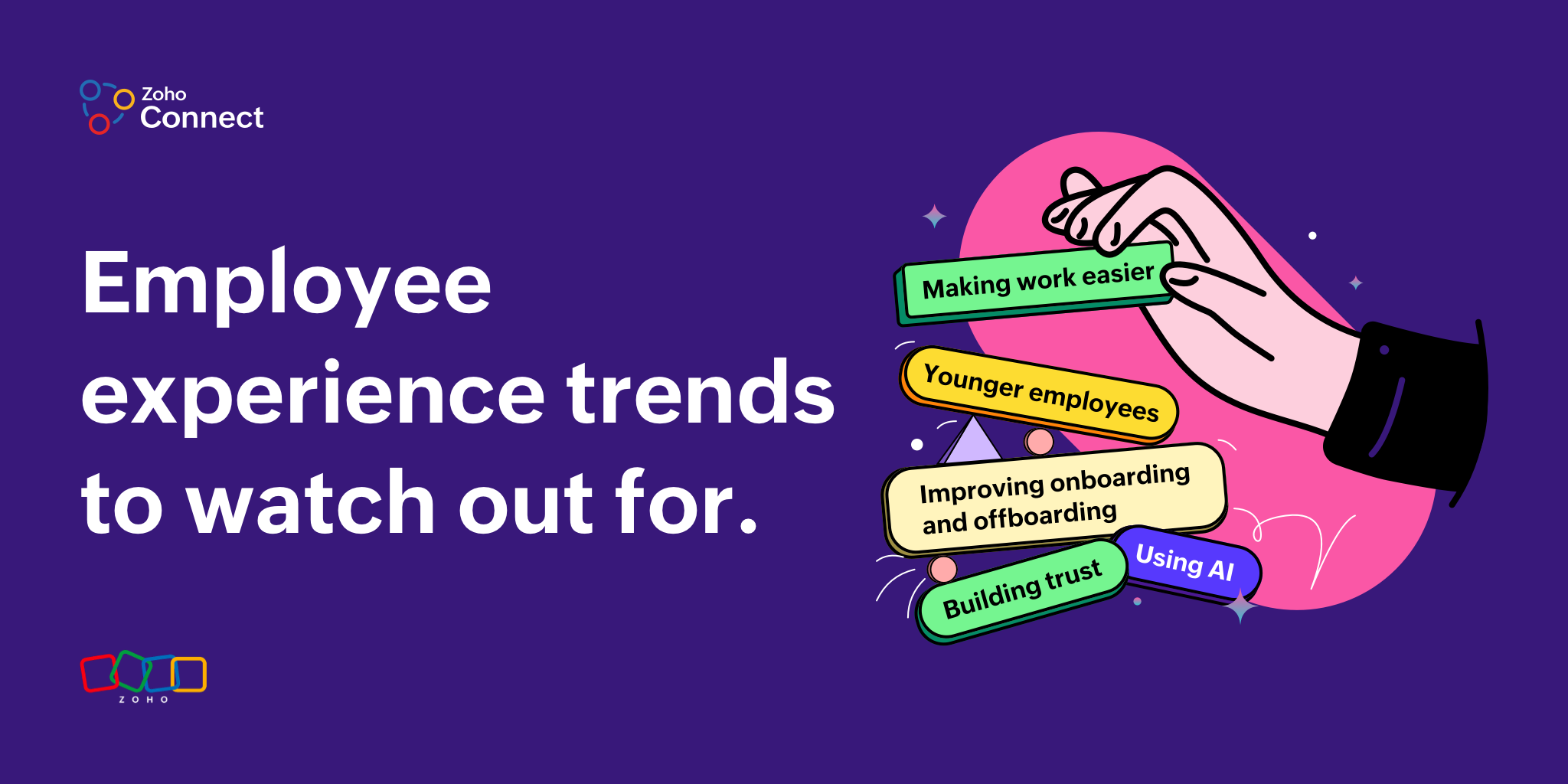- HOME
- Work Culture
- The top employee experience (EX) trends for 2025
The top employee experience (EX) trends for 2025
- Last Updated : January 2, 2025
- 583 Views
- 7 Min Read

The workplace is undergoing a significant transformation, and employee experience (EX) is at the heart of this change. With 2025 on the horizon, businesses are reimagining how they engage, support, and empower their employees.
What is employee experience, and why does it matter even more now?
Employee experience is everything that an employee goes through at work—from their first day to their last. It includes the work environment, relationships with coworkers and managers, opportunities to grow, and how well they can balance work and life. A good employee experience means that people feel valued, motivated, and connected to the company’s purpose.
Employees are looking for more than just a paycheck. They want to feel engaged, grow in their careers, and work in a supportive and inclusive environment. When employees' personal goals align with the company’s mission, they’re more likely to stay, be productive, and feel satisfied. Creating a workplace that is respectful, safe, and encourages well-being can help reduce stress and build trust. Investing in a positive employee experience leads to happier, more loyal employees, which helps the company thrive.
The future of employee experience
From remote work to AI adoption, the factors shaping employee experience are evolving rapidly. According to this Qualtrics report, five main trends will redefine EX by 2025. These trends highlight both the opportunities and challenges organizations must address to create environments where employees can thrive.
2025's best employers will simplify work for their employees
Young employees are the most hopeful.
Onboarding and offboarding challenges affect experiences.
Focusing on quick wins can hurt trust.
Teams are embracing AI to stay ahead.
1. 2025's best employers will simplify work for their employees
One of the biggest trends for top employers will be focusing on reducing the chaos in the workplace. Over the past few years, employees have been adapting quickly to change, balancing shifting demands from leaders, the market, and personal lives. But this fast-paced environment has left many employees feeling weighed down by the complexity of their roles. Simplifying work is now key to improving employee engagement.
How pressure affects employees
More than 38% of employees globally report feeling pressured to do more, driven by the pace of change. While some productivity pressure is natural, too much can hurt employee engagement and well-being, especially when employees feel they lack the support to manage it.
What can employers do to make work easier?
Provide simple and effective tools that help employees work better and faster by reducing unnecessary hurdles.
Listen to their concerns, understand their challenges, and guide them with care and empathy to adapt smoothly.
Create a workplace where employees feel comfortable sharing ideas to make work more efficient and enjoyable.
Adopt tools that gather employee feedback in real time and use it to make meaningful improvements.Give managers insights that help them understand employee needs and create a positive and supportive work environment.
2. Younger employees are the most hopeful.
Employees under the age of 25 are breaking stereotypes about their commitment and work ethic. They’re the most engaged and optimistic group in today’s workforce, eager to make an impact and add value to their organizations. This generation believes in their potential and is enthusiastic about shaping a bright future for themselves and their employers. But there’s a catch — they’re also the least likely to stay for more than three years. Organizations that fail to understand and address their unique needs risk losing this promising talent pool.
What drives younger employees to stay?
They want their career goals to align with the company’s vision.
Benefits that meet their personal needs are a priority.
Managers who embody company values inspire their loyalty.
They need to believe in the company’s mission and feel a sense of purpose.
Meaningful career development conversations are key.
How to retain young talent
Offer learning and development programs that focus on career growth, skill-building, and long-term success.
Support internal mobility programs to allow employees to explore different roles and grow within the organization.
Use data-driven tools to understand the specific needs of young employees and tailor experiences that engage and retain them.
Create a transparent roadmap for career advancement to help younger employees envision a long-term future with the company.
Encourage open communication by actively listening to their ideas and concerns, fostering a supportive environment where all voices are valued.
3. Onboarding and offboarding challenges affect employee experience.
Employee engagement is rising, but more employees are unsure about staying long-term. This doesn’t mean they’re disloyal—rather, it’s because they can’t predict the future. With uncertainty in the air, employees are adjusting their plans and thinking shorter-term about their careers.
New employees feel disconnected
One area companies are struggling with is how new employees feel when they first join. The excitement of starting a new job is fading, and many new hires aren’t seeing a long-term future with the company. Onboarding, once an exciting experience, is now showing signs of needing improvement. While onboarding still gets positive ratings, the experiences candidates have before joining and employees have when they leave are much worse.
Here’s a quick look at employee experience ratings over the past year:
Onboarding journey: 43% exceeded expectations, 15% fell short.
Candidate journey: 22% exceeded expectations, 34% fell short.
Exit experience: 28% exceeded expectations, 28% fell short.
These numbers show that the first and last impressions matter most, and organizations need to improve these experiences to build better relationships with employees.
What can organizations do?
Make new employees feel welcome and supported right from the start to set them up for success.
Create a smooth and positive hiring process that leaves a lasting impression, whether candidates are hired or not.
Leave employees with a positive final experience, even when they decide to move on.
Use tools to analyze why people stay or leave and improve the experience based on that feedback.
Give employees regular feedback to help them improve and grow in their roles.
4. Focusing on quick wins can hurt trust.
In the rush to meet short-term goals, many organizations overlook a critical asset: trust. Trust is the foundation of successful relationships, yet employees’ trust in senior leaders is lukewarm, sitting at just 63% favorability. This low level of trust can have serious consequences, from reduced morale and resistance to change to increased complaints and lower productivity.
When employees distrust their leaders, they’re less likely to go the extra mile, share honest feedback, or engage meaningfully. This creates a ripple effect that impacts the organization’s overall health and performance.
What makes leaders trustworthy?
Competence: The skills and expertise to do their job effectively.
Integrity: Acting in line with the organization’s values and principles.
Benevolence: Prioritizing employee wellbeing over short-term profits.
A majority of employees, 68%, believe their leaders are competent, and 56% feel their leaders act with benevolence.
How to build trust in leadership
Make employees feel valued by showing you care about their well-being. Leaders should go beyond being transparent and ethical—genuine care matters most.
Regularly ask employees for their thoughts and opinions. Listen carefully and act on their feedback to show that their voices matter.
Give leaders the right employee experience data to help them make better decisions. This ensures that decisions are based on real insights, not just financial figures.
5. Teams are embracing AI to stay ahead.
Artificial Intelligence (AI) is changing the way we work, helping organizations address economic challenges and adapt to a shrinking global workforce. While many companies are just beginning to explore AI’s potential, employees are already leading the charge—45% use AI tools daily or weekly to make their tasks easier and more efficient.
Employees are using AI in various ways:
Analyzing data (41%)
Online searches (40%)
Data entry (32%)
Translating languages (31%)
Writing (31%)
Despite this enthusiasm, AI adoption doesn’t automatically boost productivity. Many employees save time with AI, but 47% use it to improve work quality, 42% finish tasks faster, and 38% take on new responsibilities.
This underscores a key point: AI isn’t just about doing more; it’s about working better.
What can organizations do?
Give employees the skills they need to use AI confidently. Offer simple training so everyone knows how to use AI in their jobs.
Encourage employees to use AI to save time, so they can produce higher-quality work instead of just doing more tasks.
HR should help with training, job changes, and hiring, so that AI is smoothly introduced into the workplace.
Make sure there are clear guidelines for how to use AI responsibly. This helps employees feel safe and ensures AI is used ethically.
Keep an eye on how AI is affecting employees. Use feedback to make quick changes and improve the experience.
Wrapping up
As the workplace continues to evolve, it's time to rethink how we approach employee experience. The focus is shifting toward building strong connections, trust, and embracing new technologies. By creating supportive and inclusive environments, businesses can help their employees grow and stay ahead of the curve.
It’s not just about keeping up with change—it’s about leading it by putting your people first.
The great news? You don’t have to do it alone. With employee experience platforms like Zoho Connect, you can create a culture that encourages communication and teamwork. Start putting your employees at the heart of your business today—because when they thrive, your business thrives, too.


